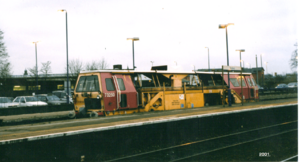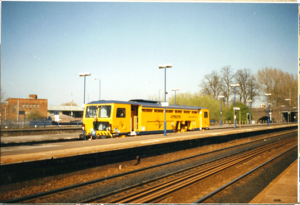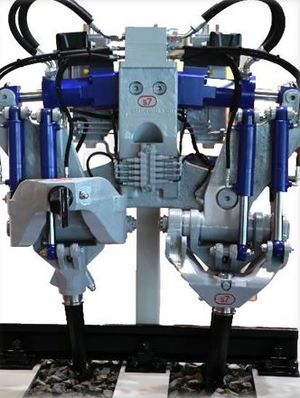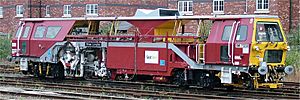Tamping machine facts for kids
A tamping machine or ballast tamper is a special train-like machine that travels on railway tracks. Its main job is to pack down the stones, called track ballast, that sit under the railway tracks. This makes the tracks strong, level, and durable, helping trains have a smooth and safe ride.
Before these machines existed, workers had to pack the ballast by hand using tools. Tamping machines are much faster, more accurate, and need fewer people. They are also essential for modern tracks that use heavy concrete sleepers, which are too heavy to lift by hand.
Some advanced tamping machines, called tamper-liners, do more than just pack ballast. They can also fix the way the rails line up, making sure they are perfectly straight and level. This helps trains run more comfortably and reduces wear and tear on the tracks. These machines work by finding spots where the tracks have sunk a little, then they lift the track and sleepers, pack new ballast underneath, and set the track back down at the correct level. Having one machine do both jobs saves a lot of time and money.
Tamping machines often work together with other machines like ballast regulators to keep the railway tracks in top condition.
Contents
How Tamping Machines Started
In the early days of railways, workers known as gandy dancers maintained the ballast by hand. They used shovels and beaters to move, clean, and pack the stones. They would even use large jacks to lift the rails so they could work underneath. This was a very slow process and could easily have mistakes.
In the 1930s, the first automatic tools for tamping were created, but people still had to operate them by hand. Over the next few decades, bigger machines were developed that could travel on the rails and do the tamping work mostly by themselves.
More recently, tamping machines have become even larger and can do many jobs at once, like lifting and aligning the tracks in addition to tamping. In North America, these are often called production tampers.
Types of Tamping Machines
Tamping machines come in different types, each designed for a specific purpose:
- Plain line tamping machines: These are used on straight sections of track that don't have switches or complex parts. They are often called production machines because they can work quickly over long distances.
- Switch tamping machines: These are designed to work on switches, crossings, and other complicated parts of the track. They have tamping tools that can move around and work in tight spaces.
How Tamping Works
The tamping process involves a few main steps, no matter what type of machine is used:
- The machine's lifting and aligning unit grabs the rails and sleepers. It then moves them into the perfect position, both up and down, and side to side.
- Next, the tamping units push special vibrating tools, called tines, into the ballast on both sides of the sleeper. These tines vibrate very fast (about 35 times per second!), which makes the ballast act almost like a liquid, allowing the tools to slide in easily.
- Once the tines are deep enough, they are pushed together underneath the sleeper. This packs the ballast tightly, making sure the sleeper stays in its new, correct position when the machine lets go.
- The tamping unit then pulls its tools back out and moves slightly above the rails. The lifting unit releases the track and sleeper, which now stay in place thanks to the packed ballast.
- Finally, the tamping machine moves forward to the next sleeper, and the whole process starts again.
Parts of a Tamping Machine
Even though different companies make tamping machines, they all work on similar ideas and have many of the same basic parts.
Power Source
Most track machines, including tampers, are powered by a diesel engine. This engine provides the energy to move the machine along the tracks and also powers the hydraulic pump. This pump creates the high-pressure fluid needed to operate all the different tools on the machine.
Lifting and Aligning Unit
The lifting and aligning unit is a crucial part of the tamping machine. It lifts the track and holds it in the correct position while the ballast is being packed.
- Chassis: This is usually a rectangular frame with four wheels that ride on the rails.
- Lifting cylinders: These are strong hydraulic cylinders on each side that connect the unit to the main machine. They lift the track up and down.
- Lining cylinders: These are horizontal cylinders that push or pull the track sideways to get the perfect alignment.
- Clamps or "hooks": These parts grab onto the sides of the railhead, locking the track to the unit before it lifts or moves.
This unit is usually connected to the main machine by an arm that can change its length. This allows the unit to move around small obstacles on the track.
Tamping Units
The tamping units are where the actual packing of the ballast happens. Most tamping units include:
- Tines: These are the tools that go into the ballast. There are usually 8 or 16 tines for each sleeper, split evenly in front and behind it.
- Guide rods: These allow the tamping unit to move smoothly up and down.
- Support frame: This holds all the parts of the tamping unit together.
- Squeezing arms: These arms push the tines together under the sleeper.
- Tine mounts: These hold the tines and can sometimes swivel.
To make the tines vibrate and pack the ballast, machines use different methods. One common way is to use a special shaft that spins unevenly, causing vibrations. Another way is to use a special hydraulic cylinder that makes the tines shake.
Special Tamping Machines
Continuous-Action Tamping Machines
A continuous-action tamping machine (CAT) can pack ballast under one to four sleepers at the same time. These machines are very efficient and can work on long stretches of track quickly.
Dynamic Tamping Express
The 'Tamping Express' is a special machine that combines continuous tamping with another process called dynamic track stabilizing. It can tamp three sleepers in a row and then also stabilize the track right away.
Dynamic Track Stabilizing (DTS)
After a track has been tamped, it can be a little less stable for a short time. This means trains might need to go slower. A dynamic track stabiliser (DTS) helps fix this faster.
A DTS machine is usually used after a track has been tamped and aligned. It has a vibrating unit that holds the track in place and applies a horizontal shake and a downward force. This makes the track settle quickly, just like many trains passing over it would.
Using a DTS has several benefits:
- It makes the track much more resistant to moving sideways.
- It creates a smooth, even bed of ballast.
- It allows trains to go back to normal speeds sooner.
- It helps the track stay in its correct position for a longer time.
One pass of a DTS can make the track as stable as if 100,000 tons of train traffic had passed over it! However, dynamic stabilizing is usually avoided on bridges or near overhead structures to prevent damage to their foundations.
Tamping and Track Layouts
The way a tamping machine works can depend on the design of the railway track.
- On straight, simple tracks, any type of tamping machine can usually be used.
- In tunnels or on bridges where there's no ballast, special steps are needed to make sure the track transitions smoothly from areas with ballast to areas without it.
- Turnouts (where tracks split or join) need more complex tamping machines. These machines have extra, adjustable tools to handle the extra rails and the different spacing of the sleepers. The same goes for tracks that have different widths (like dual gauge tracks).
Ideally, turnouts and crossings should be far enough apart so that each part can be tamped separately. However, often they are very close together, meaning they have to be tamped as a group in several small steps.
The distance between parallel tracks (called track centres) can also affect tamping. Sometimes, one track can be tamped while trains are still running on the other track.
Manufacturers
Many companies around the world build these important machines:
- MATISA Matériel Industriel SA (Switzerland)
- Plasser & Theurer / Plasser American
- Banbury Amey
- Balfour Beatty
- CHZ podbijecka
- Harsco
Images for kids
-
Czech narrow gauge tamping machine
-
Plasser & Theurer DGS 62 N dynamic track stabilizer, followed by SSP 300 Regulator, then a Plasser 09-16 CAT Continuous Action Tamper, in Blueskin Bay, New Zealand.
See also
 In Spanish: Bateadora para niños
In Spanish: Bateadora para niños
- Ballast regulator
- Gandy dancer
- Stoneblower
- Track maintenance
- Track renewal train













